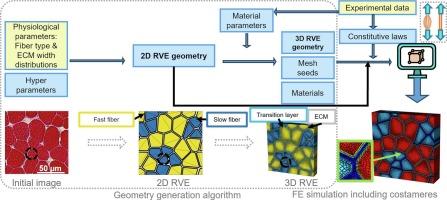An original approach to generate periodic Representative Volume Elements with anisotropic heterogeneous microstructure: application to skeletal muscle
IF 2.4
3区 医学
Q3 BIOPHYSICS
引用次数: 0
Abstract
Skeletal muscle is an organ whose hierarchical, multiscale structure greatly influences the overall mechanical response. Complementary to mechanical experiments, finite element modeling is increasingly used to study the influence of its constituents across different scales. To develop such a multiscale model, particular attention must be paid not only to the scale transition, but also to the definition of the structure and its mechanical behavior at different scales (macroscopic, microscopic, submicron). One of the most effective approaches is to define a Representative Volume Element (RVE) including smaller scale components and their respective mechanical behavior laws, likely to be altered through pathologies.
In this study, an original approach for periodic RVE generation dedicated to multiscale modeling of the skeletal muscle is proposed. From optical microscopy cross-section images of mouse skeletal muscle and single fiber experiments, the RVE integrates parameters related to fiber type distribution, geometric and mechanical characteristics. The key features of this geometry are spatial periodicity, rounded edges and inclusion of experimentally measured probabilistic distributions of the extracellular matrix (ECM), slow and fast muscle fibers. Smooth variation of the mechanical properties between the muscle fibers and the ECM are implemented to avoid unrealistic and purely numerical stress accumulation at these interfaces through the definition of transition layers between the different microcomponents. By the inclusion of custom geometrical and material features, this original model allows the multiscale and multicomponent analysis of different muscle phenotypes and can also be used for other heterogeneous anisotropic materials such as fiber reinforced composites.

一种具有各向异性异质微观结构的周期性代表性体积元生成方法:在骨骼肌中的应用
骨骼肌是一个具有层次结构和多尺度结构的器官,对其整体力学响应有很大影响。作为力学实验的补充,有限元建模越来越多地用于研究其组成部分在不同尺度上的影响。为了建立这样的多尺度模型,不仅要特别注意尺度转换,还要注意结构的定义及其在不同尺度(宏观、微观、亚微米)下的力学行为。最有效的方法之一是定义一个代表性体积单元(RVE),包括较小规模的部件及其各自的机械行为规律,可能会因病理而改变。在本研究中,提出了一种用于骨骼肌多尺度建模的周期性RVE生成方法。RVE从小鼠骨骼肌的光学显微镜横截面图像和单纤维实验中,整合了纤维类型分布、几何和力学特性等相关参数。这种几何形状的主要特征是空间周期性、圆形边缘和包含实验测量的细胞外基质(ECM)、慢速和快速肌纤维的概率分布。通过定义不同微部件之间的过渡层,实现了肌纤维和ECM之间力学性能的平滑变化,以避免在这些界面上不切实际的和纯粹的数值应力积累。通过包含定制的几何和材料特征,该原始模型允许对不同肌肉表型进行多尺度和多组分分析,也可用于其他非均质各向异性材料,如纤维增强复合材料。
本文章由计算机程序翻译,如有差异,请以英文原文为准。
求助全文
约1分钟内获得全文
求助全文
来源期刊

Journal of biomechanics
生物-工程:生物医学
CiteScore
5.10
自引率
4.20%
发文量
345
审稿时长
1 months
期刊介绍:
The Journal of Biomechanics publishes reports of original and substantial findings using the principles of mechanics to explore biological problems. Analytical, as well as experimental papers may be submitted, and the journal accepts original articles, surveys and perspective articles (usually by Editorial invitation only), book reviews and letters to the Editor. The criteria for acceptance of manuscripts include excellence, novelty, significance, clarity, conciseness and interest to the readership.
Papers published in the journal may cover a wide range of topics in biomechanics, including, but not limited to:
-Fundamental Topics - Biomechanics of the musculoskeletal, cardiovascular, and respiratory systems, mechanics of hard and soft tissues, biofluid mechanics, mechanics of prostheses and implant-tissue interfaces, mechanics of cells.
-Cardiovascular and Respiratory Biomechanics - Mechanics of blood-flow, air-flow, mechanics of the soft tissues, flow-tissue or flow-prosthesis interactions.
-Cell Biomechanics - Biomechanic analyses of cells, membranes and sub-cellular structures; the relationship of the mechanical environment to cell and tissue response.
-Dental Biomechanics - Design and analysis of dental tissues and prostheses, mechanics of chewing.
-Functional Tissue Engineering - The role of biomechanical factors in engineered tissue replacements and regenerative medicine.
-Injury Biomechanics - Mechanics of impact and trauma, dynamics of man-machine interaction.
-Molecular Biomechanics - Mechanical analyses of biomolecules.
-Orthopedic Biomechanics - Mechanics of fracture and fracture fixation, mechanics of implants and implant fixation, mechanics of bones and joints, wear of natural and artificial joints.
-Rehabilitation Biomechanics - Analyses of gait, mechanics of prosthetics and orthotics.
-Sports Biomechanics - Mechanical analyses of sports performance.
 求助内容:
求助内容: 应助结果提醒方式:
应助结果提醒方式:


